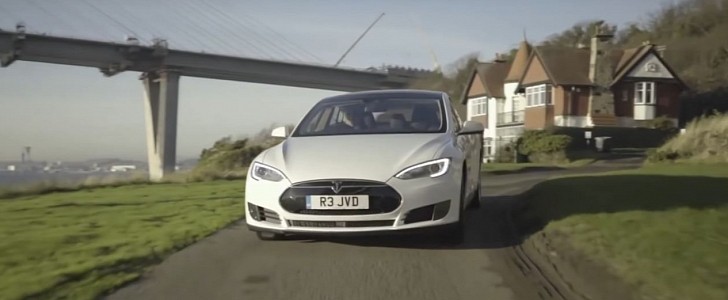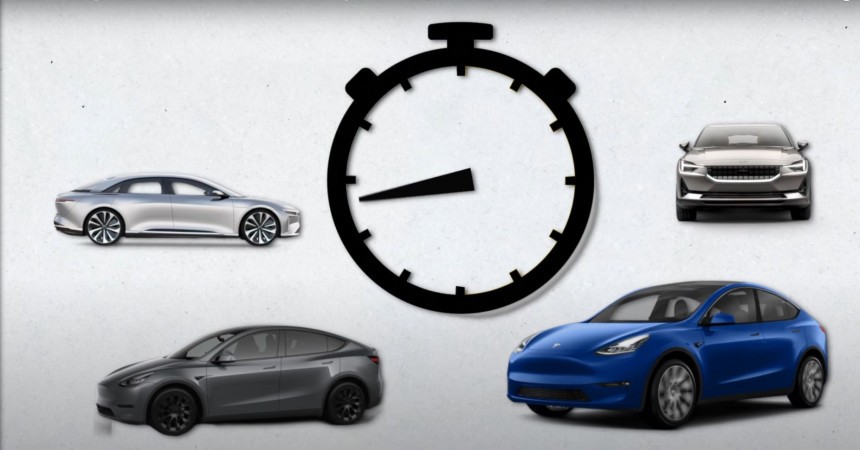Pure electric vehicles are now a major part of our lives. If you don’t own one yet, you’ll surely do so in the future. That’s where we’re heading, and there’s nothing anyone can do about it. But this U.S. mechanic says he found something unexpectedly costly with these zero tailpipe emission cars and trucks. And nobody talks about this issue! Calling it a “dark secret,” the man exposes a fact that might turn the low-maintenance aura of an EV into a costly nightmare.
There’s no doubt about it. At some point, everyone will have an all-electric car, van, or truck. Despite what many naysayers might have against these types of vehicles, our global personal and commercial transportation future is inherently linked to ditching fossil fuels and making everything electric. No matter if we’re talking about battery-electric or hydrogen-powered vehicles, the entire world will slowly but surely move on from gas, diesel, and kerosene. To put it as simply as possible, internal combustion is simply not feasible in the long run.
And even if you’re not a believer, governments around the world have already set in place bans for selling new gas or diesel vehicles. Some apply from 2030, others from 2035 or even 2040 if we’re talking about semi-trailer trucks.
Moving on, many EV owners already know this: all-electric vehicles require cheap maintenance. It’s an incredible advantage. There’s little that can go wrong. This, of course, comes with some repercussions for jobs and businesses in the automotive industry but also opens the door for multiple new opportunities. Take Tesla, for example; they’re constantly pushing ahead with the autonomous driving software that owners today agree to pay for.
And keep in mind: some of these costly features are not even finished. People pay to become testers while assuming full responsibility if something goes wrong.
Just imagine if someone was to tell you 20 years ago that you had to pay a monthly subscription for your car just to make sure you’re having everything working on it. That would’ve surely been a dealbreaker. Not anymore! The world’s changing.
The mechanic-turned-YouTuber says that some EV manufacturers reported their cars’ tires must be replaced after just 28,000 mi (45,000 km). According to the U.S. Tire Manufacturers Association, cars would normally travel about 60,000 mi (96,560 km) on a set of fresh tires before they’d need replacing. That’s mostly why Scotty Kilmer argues the low-maintenance advantage of EVs is a facade.
He also argues that EV owners might be inclined to test their cars’ acceleration more often just to feel the instantaneous acceleration or to show their friends why they should switch to the zero-emission side. This would, of course, lead to increased wear. Moreover, Kilmer says new tires must also support increased weight. Almost all EVs are heavier than their internal combustion counterparts.
The mechanic takes the Tesla Model 3 as an example and shows that installing new tires on a car like this would amount to $1,300 before tax. He says this value is similar to what drivers of sports cars pay. Moreover, a Model 3 driver would need to go into their pocket more often because factory-installed Tesla EV tires don't have the run-flat advantage. In case of a puncture, you risk being stranded on the side of the road until someone can help you. At the same time, these tires used by the American EV maker might contain better synthetic rubber and have improved stopping power, but the available options are limited. This is true, especially for all-wheel-drive models, and it also means that you'll eventually spend more to get the proper tires that work best with your Tesla.
“If you’re not careful (…) and you don’t rotate the tires as needed, well, then the frequency you need to replace your EV tires will get very pricey, very fast,” says the mechanic.
To be safe at all times while on the road, make sure you read the instructions offered by the manufacturer. Tires need to be rotated in two-wheel-drive (2WD) cars that are either front-wheel-drive (FWD) or rear-wheel-drive (RWD) because the ones that are used to put the power down are wearing out faster. In some cases, all-wheel-drive (AWD) cars must also have their tires rotated. If your vehicle has traction on all four wheels, but it sends the power to the rear axle more often (like it happens with the Model S, for example), you have to rotate the tires for even wear. Otherwise, you might end up needing new tires too often. According to Tesla, tires must be rotated every 6,250 miles (10,000 km) or if the tread depth difference is 2/32 in (1.5 mm) or greater.
One of Scotty Kilmer’s followers says he works as a technician for a big EV producer, and the number of tires he has to change daily is “staggering.” He confirms they are expensive and also supports the mechanic’s assessment regarding the wear caused by the increased weight and power of EVs.
Besides “the dark secret” exposed by Kilmer, we should also remember that tires are hard to recycle. If they need replacing more often, this can lead to an environmental disaster. For now, only the European Union has harsh regulations in place when it comes to properly disposing of tires. Almost 95% of the units sold are being safely used in other industries like cement manufacturing.
Unfortunately, in other parts of the world like Kuwait or Hawaii, tire dumping remains a huge problem. Some people like to burn them, but the smoke is highly toxic. Tires can’t also be disposed of at landfills because of trapped methane that can damage liners used to protect the ground from contaminants.
At the end of the day, if you have an EV, make sure to rotate your tires as the manufacturer recommended. You’ll avoid the costs associated with buying new tires, and you’ll also avoid contributing to the pollution of the environment.
And even if you’re not a believer, governments around the world have already set in place bans for selling new gas or diesel vehicles. Some apply from 2030, others from 2035 or even 2040 if we’re talking about semi-trailer trucks.
Moving on, many EV owners already know this: all-electric vehicles require cheap maintenance. It’s an incredible advantage. There’s little that can go wrong. This, of course, comes with some repercussions for jobs and businesses in the automotive industry but also opens the door for multiple new opportunities. Take Tesla, for example; they’re constantly pushing ahead with the autonomous driving software that owners today agree to pay for.
And keep in mind: some of these costly features are not even finished. People pay to become testers while assuming full responsibility if something goes wrong.
The mechanic’s warning
But EVs also hide “a dark secret,” as Scotty Kilmer says. The mechanic admits that all-electric vehicles don’t require the same amount of spending to keep them running properly. However, he underlines owners do not know something that may cost them a lot in the future: the tires are unexpectedly expensive. The man says you’ll have to spend a fortune just to change them.The mechanic-turned-YouTuber says that some EV manufacturers reported their cars’ tires must be replaced after just 28,000 mi (45,000 km). According to the U.S. Tire Manufacturers Association, cars would normally travel about 60,000 mi (96,560 km) on a set of fresh tires before they’d need replacing. That’s mostly why Scotty Kilmer argues the low-maintenance advantage of EVs is a facade.
He also argues that EV owners might be inclined to test their cars’ acceleration more often just to feel the instantaneous acceleration or to show their friends why they should switch to the zero-emission side. This would, of course, lead to increased wear. Moreover, Kilmer says new tires must also support increased weight. Almost all EVs are heavier than their internal combustion counterparts.
Costly and polluting
On top of all this, Kilmer argues that tires for EVs are generally more expensive because they also need to be quieter. The absence of an engine can lead to more road-noise, and on long runs, this can become annoying.“If you’re not careful (…) and you don’t rotate the tires as needed, well, then the frequency you need to replace your EV tires will get very pricey, very fast,” says the mechanic.
To be safe at all times while on the road, make sure you read the instructions offered by the manufacturer. Tires need to be rotated in two-wheel-drive (2WD) cars that are either front-wheel-drive (FWD) or rear-wheel-drive (RWD) because the ones that are used to put the power down are wearing out faster. In some cases, all-wheel-drive (AWD) cars must also have their tires rotated. If your vehicle has traction on all four wheels, but it sends the power to the rear axle more often (like it happens with the Model S, for example), you have to rotate the tires for even wear. Otherwise, you might end up needing new tires too often. According to Tesla, tires must be rotated every 6,250 miles (10,000 km) or if the tread depth difference is 2/32 in (1.5 mm) or greater.
One of Scotty Kilmer’s followers says he works as a technician for a big EV producer, and the number of tires he has to change daily is “staggering.” He confirms they are expensive and also supports the mechanic’s assessment regarding the wear caused by the increased weight and power of EVs.
Besides “the dark secret” exposed by Kilmer, we should also remember that tires are hard to recycle. If they need replacing more often, this can lead to an environmental disaster. For now, only the European Union has harsh regulations in place when it comes to properly disposing of tires. Almost 95% of the units sold are being safely used in other industries like cement manufacturing.
Unfortunately, in other parts of the world like Kuwait or Hawaii, tire dumping remains a huge problem. Some people like to burn them, but the smoke is highly toxic. Tires can’t also be disposed of at landfills because of trapped methane that can damage liners used to protect the ground from contaminants.
At the end of the day, if you have an EV, make sure to rotate your tires as the manufacturer recommended. You’ll avoid the costs associated with buying new tires, and you’ll also avoid contributing to the pollution of the environment.













